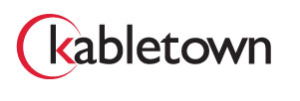In the fourth season of the sitcom 30 Rock, NBC (in the world of the show) is taken over by the fictional company Kabletown. The real NBC put up a website for the company, which is accessible through the official page for 30 Rock, and has a prominent banner at the top linking back to the official site. The site itself is quite basic, consisting of just five pages containing images and text.

NBC leaves no doubt that Kabletown.com is an extension of 30 Rock, with a big orange banner at the top.
The Kabletown story arc is self-reflexive in that it acknowledges the reality of the company producing the television show. At the same time that the episodes involving the Kabletown takeover were airing, Comcast was taking over NBC in real life. Since 30 Rock is a television show about making a television show, it regularly engages in satirical references to NBC and its parent company, General Electric, which are also the parent companies to The Girlie Show (the television sketch series that 30 Rock revolves around). By mimicking Comcast’s logo in the design of the Kabletown logo, 30 Rock eliminates any doubt about the coincidence of the plot line with events in reality.

The Comcast logo.
Furthermore, since the website was put up by NBC, it is referencing itself and acknowledging that much of the show’s content reflects its author’s (Tina Fey) own experiences working for NBC on Saturday Night Live. However, beyond the somewhat autobiographical aspects of the series, 30 Rock is a weird show, and this weirdness is thoroughly expressed in the text of Kabletown.com. The tone is completely unprofessional and ridiculous, in a style that is very recognizably 30 Rock for fans of the show. By pushing Kabletown onto the Internet but retaining the absurd 30 Rock flavor, NBC creates a little piece of the 30 Rock world in reality, without ever creating the illusion that Kabletown could be anything other than a fake company. This is not usually how worldbuilding works, as expressed in Henry Jenkin’s idea of expanding a world to entice viewers to try to find out more. However, for 30 Rock, this approach is way more effective than trying to make a serious, intriguing website. 30 Rock never takes itself to seriously, and the Kabletown website brings a bit of that into a form that viewers can interact with as they poke around the website. They won’t discover little nuggets about the narrative of 30 Rock that they didn’t already know from watching the show, but exploring the website gives viewers the opportunity to engage with the show (and its sense of humor) in another medium. It also creates a sense of being in on the joke, which encourages viewer loyalty by forging a sense of community.
Sources:
Jenkins, Henry. “Transmedia Storytelling 101.” Web log post. Confessions of an AcaFan. N.p., 22 Mar. 2007. Web. 22 Feb. 2015.
